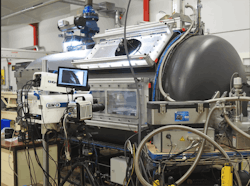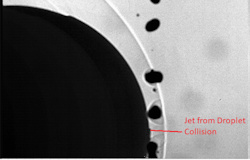Ultrahigh-speed cameras provide a look into the hypervelocity world
Hypervelocity is defined by the Collins English dictionary as extremely high speed—usually more than 3,000 meters/s. The effects of collisions at hypervelocity are of particular concern within the fields of space exploration and the military in space, where hypervelocity impacts can result in minor component degradation or the complete destruction of a spacecraft or missile. The impactor, as well as the surface it hits, can undergo temporary liquefaction and/or vaporization that can compromise aerodynamic properties. With solid impactors, the impact process can also generate plasma discharges, which can interfere with spacecraft electronics.
Studying the effects of hypervelocity impacts is vital in the development of safer construction techniques for space vehicles and missiles, but generating repeatable events in a controlled environment is far from straightforward.
The majority of hypervelocity impact studies are laboratory based and use a light-gas gun, similar to the Southwest Research light-gas gun (see Fig. 1), to accelerate a particle to beyond 3,000 m/s. In a typical light-gas gun setup, a projectile is accelerated down a long smooth bore tube. The projectile may be wrapped in a sabot (a piece of packing to protect the projectile while within the barrel). Upon exiting the muzzle, the sabot will separate and allow the projectile to travel onward to the impact point. Upon striking the target a burst of plasma may be emitted, a cloud of dust and fragments that consists of both projectile and target material will be ejected, and it may spall (material from the target may break off the reverse side).
An event window for studying the fundamental dynamics of a hypervelocity impact can range between a few hundred nanoseconds to a hundred microseconds. Shorter times are used to explore phenomena such as the plasma generated from an impact, while longer event times are required to study the fragmentation cloud, the spalling from the impact, or structural integrity during and after the impact.
Ultrahigh-speed cameras
As with any high-speed imaging application, timing is everything. If an impactor is travelling at 5 km/s, then it travels 5 m within the time it takes you to blink. A small (2-mm) projectile will move its own diameter within ~4 µs at this speed. When taking images of moving objects, to avoid capturing a blurred image the exposure time should be short enough to limit the movement of a subject to be less than a pixel of the final image.
For example, if an image is 1,000 pixels wide with a field of view of 10 cm, each pixel will be 100 µm across (0.1 mm). Our 2-mm projectile traveling at 5 km/s will traverse a pixel within 200 ns (see Fig. 2). It requires a frame rate of at least 5 million pictures/s to freeze the motion. Even the fastest modern high-speed video camera would be unusable at this speed, so special cameras are required to get these kinds of results.
Specialised Imaging Ltd. is working closely with researchers to develop ultrahigh-speed cameras targeting these types of imaging speeds. Modern framing cameras are capable of capturing images at rates up to one billion frames/s, but suffer from the major drawback of only capturing a limited number of images (typically between 8 to 180, depending on the camera type). The most significant issue arising from having a limited number of images is that the trigger timing becomes critical. Miss the trigger by a microsecond and it’s hundred frames at 100 million frames/s. At the very fastest capture speeds, a 10-m cable will delay the trigger by as many as 60 frames, so even the length of wires needs to be considered.
This is all part of everyday life for our hypervelocity researchers who take advantage of the sophisticated triggering built into the latest ultrahigh-speed cameras (see Fig. 3). Features such as an integrated velocity trap automatically calculate the arrival time of a projectile at a target from two strategically placed triggers.
Imaging projectiles and impacts
By knowing the distance between the two triggers and the field of view of the camera, the actual velocity can be measured and the delay recalculated before the projectile arrives within the field of view. Accurate triggers like laser-diode/photodiode pairs can be integrated into a gas gun experiment so that every projectile is detected, and no shots are missed. Using a single trigger will not take account of the natural variability of the velocity from a light gas gun launcher, and the timing could easily be far enough out to miss the event completely.
A recent example of a hypervelocity study was the research carried out by The Stevens Institute of Technology and the Southwest Research Institute. In this study, researchers used Specialised Imaging Ltd.’s Kirana high-speed video camera to explore the effects of liquid and solid impacts on hypersonic aerospace bodies.
When an object moves through the atmosphere at hypervelocity, it can easily become damaged by dust particles or water droplets suspended within the atmosphere. Simply firing dust particles or liquid droplets at samples of material is not always useful for understanding these interactions or is often not even possible. So researchers devised experiments to study the effects of hypersonic bodies moving through the path of droplets to simulate real-world weather phenomena.
Since the size and shape of an impacting droplet determines the amount of damage it does to materials during a high-speed collision, it is important to characterize their exact breakup behavior. The experimental approach used by the Stevens Institute of Technology used a light-gas gun facility to accelerate various materials to high velocities, introduce water droplets, and study their interactions via advanced diagnostic techniques and camera systems.
A Kirana ultrahigh-speed video camera operating at 5 million frames/s was used to image the interaction of a projectile (traveling at 2.4 km/s velocity) with a stream of liquid water droplets within a low-pressure nitrogen medium. Laser-backlit shadowgraph techniques were used to capture the images (see Fig. 4). Shadowgraphs allow visualization of shockwaves because compression of the atmosphere as an object moves through it causes refraction of the light. The lighter and darker areas that appear within the field of view, as a result of the lensing caused by the denser compressed gasses, show the shockwaves very clearly.
Results in this experiment clearly showed that droplet breakup phenomena including edge-stripping behavior, liquid jetting from the droplet-projectile impact point, and other multiphase hypersonic flow phenomena occurred during the interaction.
It’s now possible to see what is going on within the hypervelocity world and to study phenomena that could prevent the successful launch of spacecraft or satellites. This has only become possible by building on many years of development of high-speed camera systems, lighting, and launching systems. It takes the expertise of scientists and engineers from across many disciplines to achieve, but sometimes the invisible can be seen, and these tools and techniques which help make the world a safer place.
FURTHER READING
About the Author
Keith Taylor
Keith Taylor is a director of Specialised Imaging (Pitstone, U.K.).



